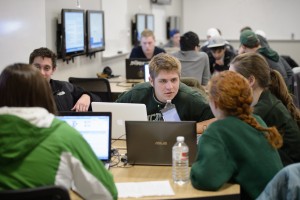It seems that every year those who work in education whip out their magic crystal balls and attempt to predict what trends will have the greatest impact in the classroom. All of us want to create meaningful experiences for the students and often that means trying to anticipate what their classroom expectations will be. If possible, we would even like to exceed those expectations.
Personalization & engagement
The past few years have seen a move toward a greater emphasis on personalization and engagement. In many ways, we are attempting to artificially recreate the ways in which we learned before formal institutions, when we experienced things in the world, instead of hearing about them in a classroom.
Luckily, technology has allowed us to start crafting those experiences in a directed and purposeful way. At the same time, the benefits of housing these experiences inside a center of learning can still be utilized.
Classroom customization
The first major trend, though it should really be called a continuation of a trend, is the emphasis on adjustable classrooms and makerspaces. While from the outside these may appear to be separate things, they really are centered around the same goal of fitting the classroom experience to students’ needs.
Campuses across the United States have begun implementing flipped classrooms that focus on allowing students to collaborate easily. In addition, the idea of the lecture hall as the primary go-to for knowledge is being re-examined often with an online, asynchronous component. The Rooms for Engaged and Active Learning (REAL) are an example of flipped classrooms at MSU.
Makerspaces, where students can create and actively engage in learning through experiences, are also becoming more prevalent. MSU has several examples of these spaces. There are makerspaces at the MSU Library called MakeCentral, as well as the MSU Hatch. See Make @ State for more MSU makerspace resources.
Micro-learning
Micro-learning is a style of imparting information in small chunks taking into consideration our short attention spans. The basic idea is to provide short bursts of information, and then allow students space and time to reflect and discuss that information. This is another trend moving away from the traditional classroom lecture format.
The most obvious example of micro-learning is the emphasis on short instructional videos in online and flipped classes. This is exemplified in the model advocated by Coursera and other platforms that offer Massive Open Online Courses or MOOCs. IT Services also recommends this approach when instructors are designing and creating online videos. More information about our approach to instructional videos can be found at the Hub’s blog post “Why Choose Video.”
The micro-learning trend is not confined to video or even to the digital realm. Podcasts, games, and simulations could all be added to any instructional style. All that is required is some planning and creative thinking.
Virtual reality
There probably isn’t a more dramatic example of the future educational possibilities than the advent of learning experiences in virtual reality. While there has been a continued effort to create digital learning simulations for decades, the technology hasn’t been available until recently to make these experiences accessible to a wide audience.
Now, not only is it possible for students to experience places that they would never have normally been able to travel, but they can also craft their own experiences and share them with others. Two services, Google Expeditions and ThinkLink 360 are great places to start exploring how to integrate virtual reality into the classroom.
Moving forward in education
These new active learning trends provide some amazing opportunities for faculty and instructors to engage and excite students. Never before in history have the tools and resources been more accessible to provide lasting and meaningful experiences to broad groups of people.
Learning should be fun for the student and the teacher, so try something new in your classroom. It doesn’t even have to be a whole course redesign, it could just be a lesson, or a single activity. If you tell your students that you are trying something new, I’m sure most would love to give you feedback.
MSU IT provides instructional design and development services to help faculty instructors discuss and determine how to integrate new active learning options. Request a consultation by calling (517) 432-6200 or emailing ithelp@msu.edu.



